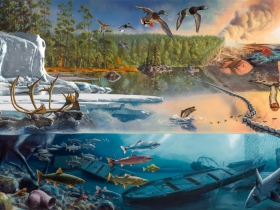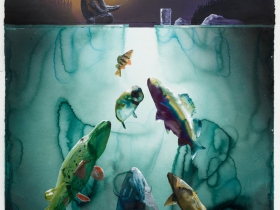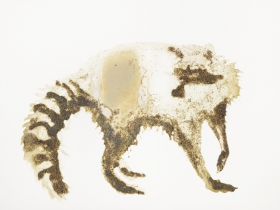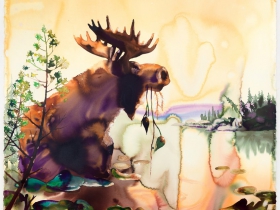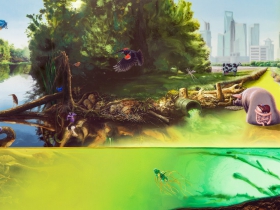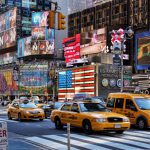The Not So Great Lakes
Painter Alexis Rockman captures the threatened beauty of the Great Lakes in Haggerty show.
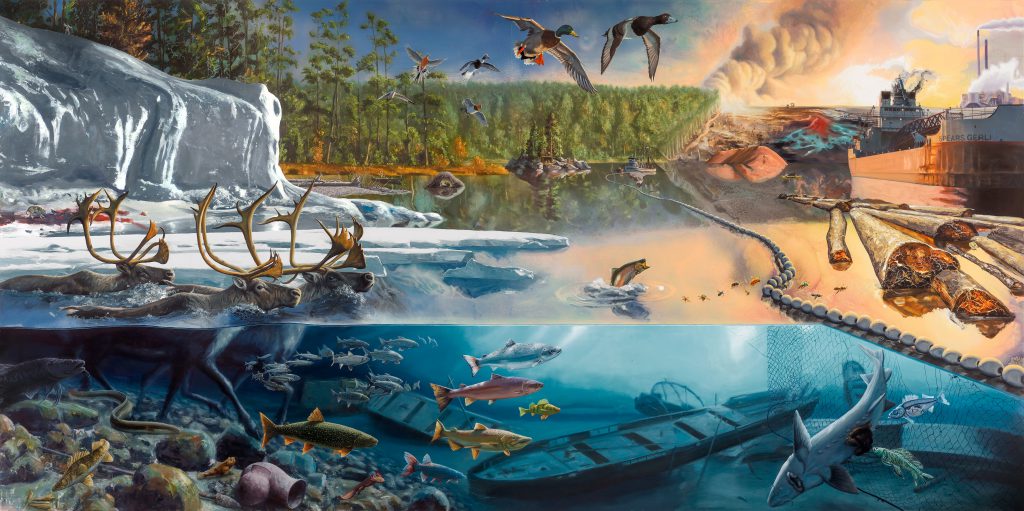
“Cascade,” 2015, oil and alkyd on wood panel, 72 x 144 inches. Commissioned by Grand Rapids Art Museum with funds provided by Peter Wege, Jim and Mary Nelson, John and Muriel Halick, Mary B. Loupee, Karl and Patricia Betz, and general accessions funds. Grand Rapids Art Museum, 2015.19
New York artist and environmental activist Alexis Rockman’s latest exhibit acknowledges the breathtaking beauty of the five Great Lakes ecosystems, while commenting on how factors like climate change, mass agriculture and industry have affected, and continue to affect, these vital natural resources.
Organized by Michigan’s Grand Rapids Art Museum, “The Great Lakes Cycle” will be on display through May 19 at Marquette University’s Haggerty Museum of Art. The exhibit features five large-scale (6 x 12-foot) oil and alkyd paintings, more than two dozen field drawings, created with natural materials including soil, sand and leaves, and six watercolor and acrylic paintings.
The exhibit “is mostly about the majesty of nature, and the impact we are having on it,” said Susan Longhenry, Haggerty director. Milwaukee, which is fortunate enough to be located on the picturesque Lake Michigan, is a city increasingly known for its water management and water quality technologies.
Rockman, who was born in New York City in 1962, has had an interest in nature and the environment since childhood, watching nature documentaries, frequently visiting the city’s Museum of Natural History, and drawing animals from books.
Rockman’s works explore how the lakes have changed over more than 10,000 years, largely due to human and industrial activity. “Cascade” chronicles the lakes’ history, from serenity to tragedy to what seems like irreparable damage. To the left of the painting, several moose swim, mallards fly through the air and a waterfall cascades, while on the right, a ship belches smoke near a river of what appears to be toxic waste and burning logs float on the water. Below the waterline fish and a shark swim by a broken lifeboat (or canoe), wire fencing and car tires.
Rockman’s use of detail in works like “Cascade,” from the scales on the fishes to the wings of mallard ducks to billowing smoke clouds of distant freighters, is stellar. His vivid colors of nature, icy whites, tranquil greens, and many shades of blue, contrast with the sickly yellows, grays, and oranges associated with chemicals, pollutants and industry.
Rockman explores how invasive species and pollutants can significantly disrupt and alter a freshwater ecosystem.
In his watercolor “Chimera” (2017), for example, a series of brightly-colored fish and crustaceans appear to be cannibalizing one another, perhaps to represent how native species can be “swallowed up” or driven out by invasive ones. An oil painting, “Forces of Change” (2017), illustrates a mass of tentacles, symbolizing harmful bacteria that have upset the ecological balance, either a consequence of pollution or invasive species, while his watercolor and acrylic work, “Drop of Water”. magnifies several brilliantly-colored microbes found in a single miniscule drop of water.
Rockman also examines how large-scale farming has affected great lakes habitats, particularly in 2015’s “Watershed.” A jewel-colored ear of corn and a mutated chicken mark the results of genetic modification, while a drone flies overhead. There are no human figures pictured. Harmful fertilizers contaminate the once-pristine blue water, turning it a pale green.
The artist’s monochromatic field drawings of plants and animals, among them a raccoon, tree frog, double crested cormorant, wood duck, and river otter, bring to mind vintage natural history textbooks. The drawings, created from pigments made up of sand, soil and leaves from Great Lakes areas (including Wisconsin’s Presque Isle) are earthly colors—olive green, reddish brown, and charcoal gray. By using natural materials, Rockman is truly preserving nature through his art.
Two watercolors, “Upper Peninsula” and “Ice Fishing,” embrace quiet contemplation. A moose sits placidly in a body of water, munching leaves. A lone fisherman casts his rod on a frozen lake, illuminated by yellow-greenish lights while a shark and a handful of smaller fish appear preserved below the surface.
Rockman’s highly educational exhibit also includes a digital component: a variety of short informational videos about a number of Milwaukee organizations involved in freshwater initiatives, including Alice’s Garden and the public art initiative Watermarks.
“The Great Lakes Cycle” Gallery
“The Great Lakes Cycle,” through May 19 at the Haggerty Museum of Art, 1234 W. Tory Hill St., Milwaukee.
If you think stories like this are important, become a member of Urban Milwaukee and help support real independent journalism. Plus you get some cool added benefits, all detailed here.
Art
-
Winning Artists Works on Display
 May 30th, 2024 by Annie Raab
May 30th, 2024 by Annie Raab
-
5 Huge Rainbow Arcs Coming To Downtown
 Apr 29th, 2024 by Jeramey Jannene
Apr 29th, 2024 by Jeramey Jannene
-
Exhibit Tells Story of Vietnam War Resistors in the Military
 Mar 29th, 2024 by Bill Christofferson
Mar 29th, 2024 by Bill Christofferson



